The Australian Constitution and the Shift in Federal Power Dynamics.
VerifiedAdded on 2023/06/11
|6
|1635
|499
Essay
AI Summary
This essay examines the shift in Australia's federal system, focusing on the evolving interpretation of the Australian Constitution. Initially, the constitution granted significant powers to state governments, but over time, the Commonwealth government has acquired more authority. The essay highlights the Engineers' Case as a pivotal moment in this shift, where the High Court's interpretation significantly altered the balance of power between state and federal entities. Section 109 and 61 of the constitution are discussed to show the overriding power of the central government and the Queen. The essay concludes that the increasing dominance of the Commonwealth has implications for the economy and the GDP of the country, and suggests the need for constitutional amendments to restore a more balanced federal structure. Desklib provides a platform for students to access similar essays and study resources.
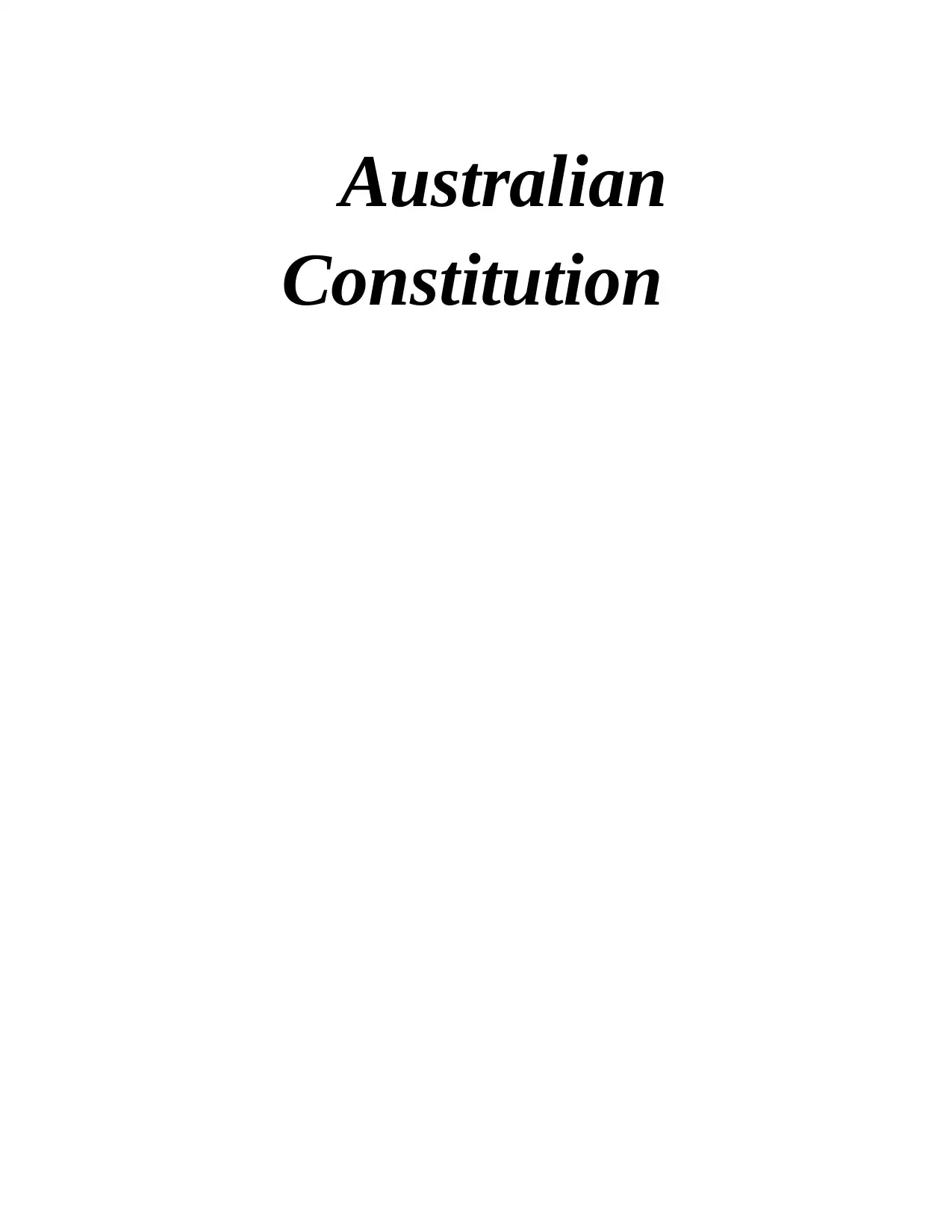
Australian
Constitution
Constitution
Paraphrase This Document
Need a fresh take? Get an instant paraphrase of this document with our AI Paraphraser
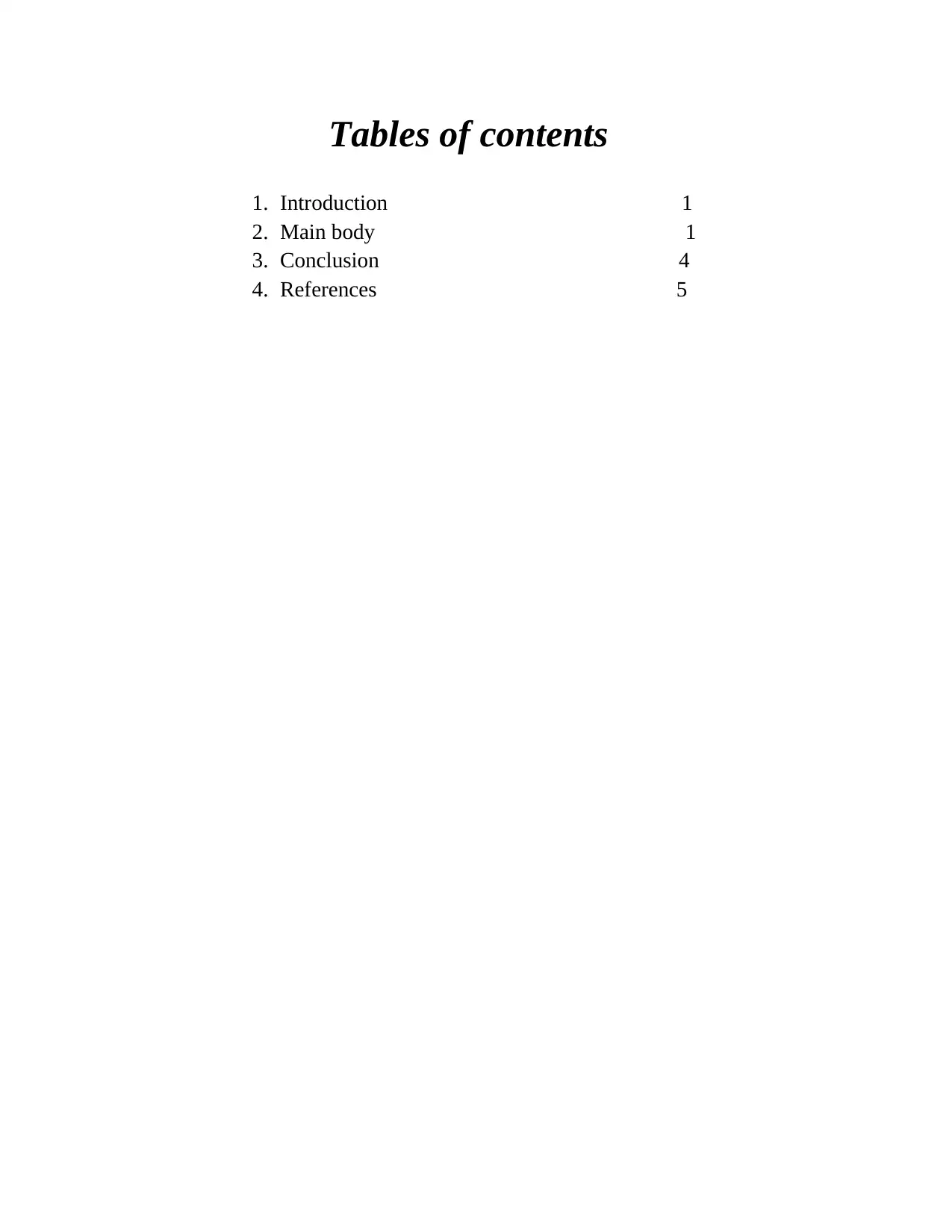
Tables of contents
1. Introduction 1
2. Main body 1
3. Conclusion 4
4. References 5
1. Introduction 1
2. Main body 1
3. Conclusion 4
4. References 5
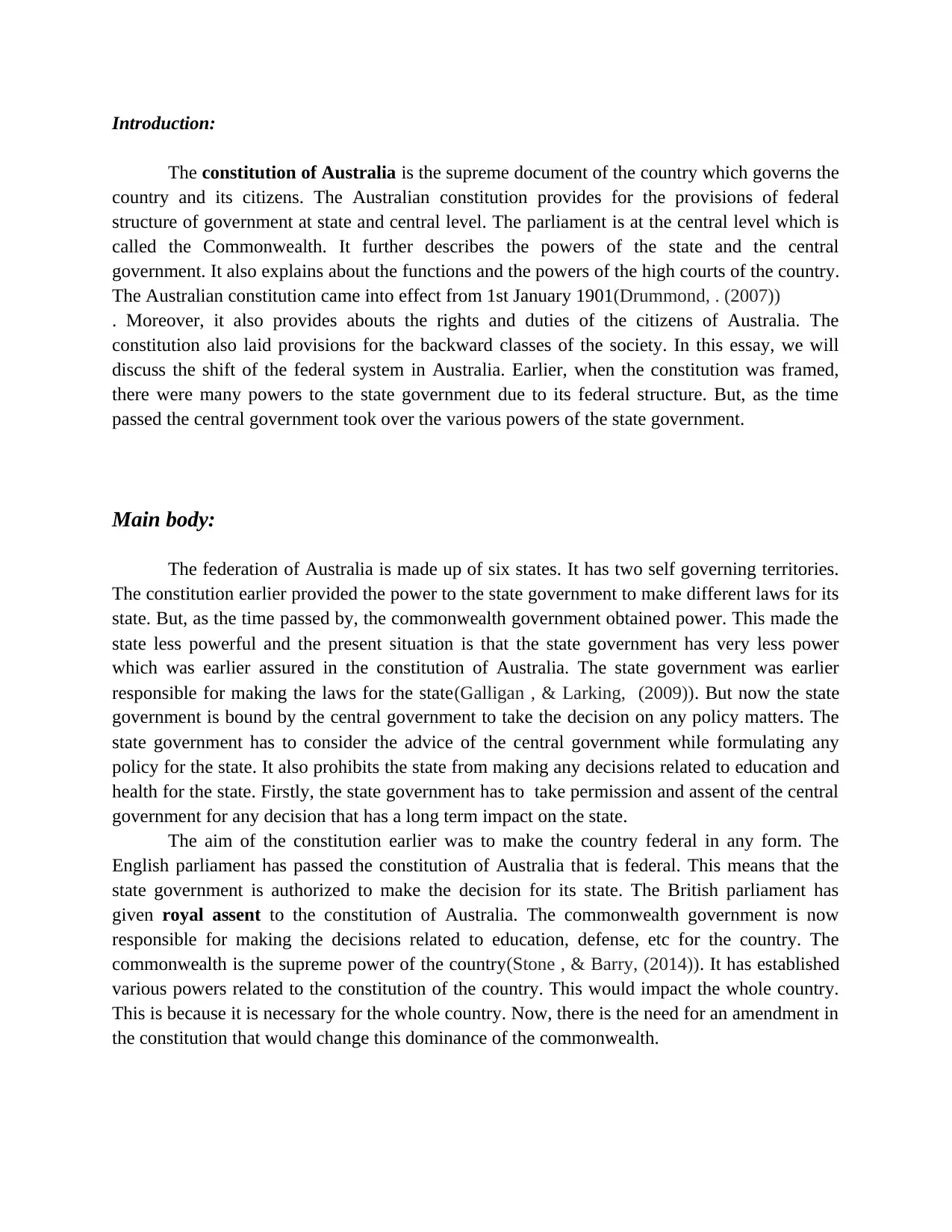
Introduction:
The constitution of Australia is the supreme document of the country which governs the
country and its citizens. The Australian constitution provides for the provisions of federal
structure of government at state and central level. The parliament is at the central level which is
called the Commonwealth. It further describes the powers of the state and the central
government. It also explains about the functions and the powers of the high courts of the country.
The Australian constitution came into effect from 1st January 1901(Drummond, . (2007))
. Moreover, it also provides abouts the rights and duties of the citizens of Australia. The
constitution also laid provisions for the backward classes of the society. In this essay, we will
discuss the shift of the federal system in Australia. Earlier, when the constitution was framed,
there were many powers to the state government due to its federal structure. But, as the time
passed the central government took over the various powers of the state government.
Main body:
The federation of Australia is made up of six states. It has two self governing territories.
The constitution earlier provided the power to the state government to make different laws for its
state. But, as the time passed by, the commonwealth government obtained power. This made the
state less powerful and the present situation is that the state government has very less power
which was earlier assured in the constitution of Australia. The state government was earlier
responsible for making the laws for the state(Galligan , & Larking, (2009)). But now the state
government is bound by the central government to take the decision on any policy matters. The
state government has to consider the advice of the central government while formulating any
policy for the state. It also prohibits the state from making any decisions related to education and
health for the state. Firstly, the state government has to take permission and assent of the central
government for any decision that has a long term impact on the state.
The aim of the constitution earlier was to make the country federal in any form. The
English parliament has passed the constitution of Australia that is federal. This means that the
state government is authorized to make the decision for its state. The British parliament has
given royal assent to the constitution of Australia. The commonwealth government is now
responsible for making the decisions related to education, defense, etc for the country. The
commonwealth is the supreme power of the country(Stone , & Barry, (2014)). It has established
various powers related to the constitution of the country. This would impact the whole country.
This is because it is necessary for the whole country. Now, there is the need for an amendment in
the constitution that would change this dominance of the commonwealth.
The constitution of Australia is the supreme document of the country which governs the
country and its citizens. The Australian constitution provides for the provisions of federal
structure of government at state and central level. The parliament is at the central level which is
called the Commonwealth. It further describes the powers of the state and the central
government. It also explains about the functions and the powers of the high courts of the country.
The Australian constitution came into effect from 1st January 1901(Drummond, . (2007))
. Moreover, it also provides abouts the rights and duties of the citizens of Australia. The
constitution also laid provisions for the backward classes of the society. In this essay, we will
discuss the shift of the federal system in Australia. Earlier, when the constitution was framed,
there were many powers to the state government due to its federal structure. But, as the time
passed the central government took over the various powers of the state government.
Main body:
The federation of Australia is made up of six states. It has two self governing territories.
The constitution earlier provided the power to the state government to make different laws for its
state. But, as the time passed by, the commonwealth government obtained power. This made the
state less powerful and the present situation is that the state government has very less power
which was earlier assured in the constitution of Australia. The state government was earlier
responsible for making the laws for the state(Galligan , & Larking, (2009)). But now the state
government is bound by the central government to take the decision on any policy matters. The
state government has to consider the advice of the central government while formulating any
policy for the state. It also prohibits the state from making any decisions related to education and
health for the state. Firstly, the state government has to take permission and assent of the central
government for any decision that has a long term impact on the state.
The aim of the constitution earlier was to make the country federal in any form. The
English parliament has passed the constitution of Australia that is federal. This means that the
state government is authorized to make the decision for its state. The British parliament has
given royal assent to the constitution of Australia. The commonwealth government is now
responsible for making the decisions related to education, defense, etc for the country. The
commonwealth is the supreme power of the country(Stone , & Barry, (2014)). It has established
various powers related to the constitution of the country. This would impact the whole country.
This is because it is necessary for the whole country. Now, there is the need for an amendment in
the constitution that would change this dominance of the commonwealth.
⊘ This is a preview!⊘
Do you want full access?
Subscribe today to unlock all pages.

Trusted by 1+ million students worldwide
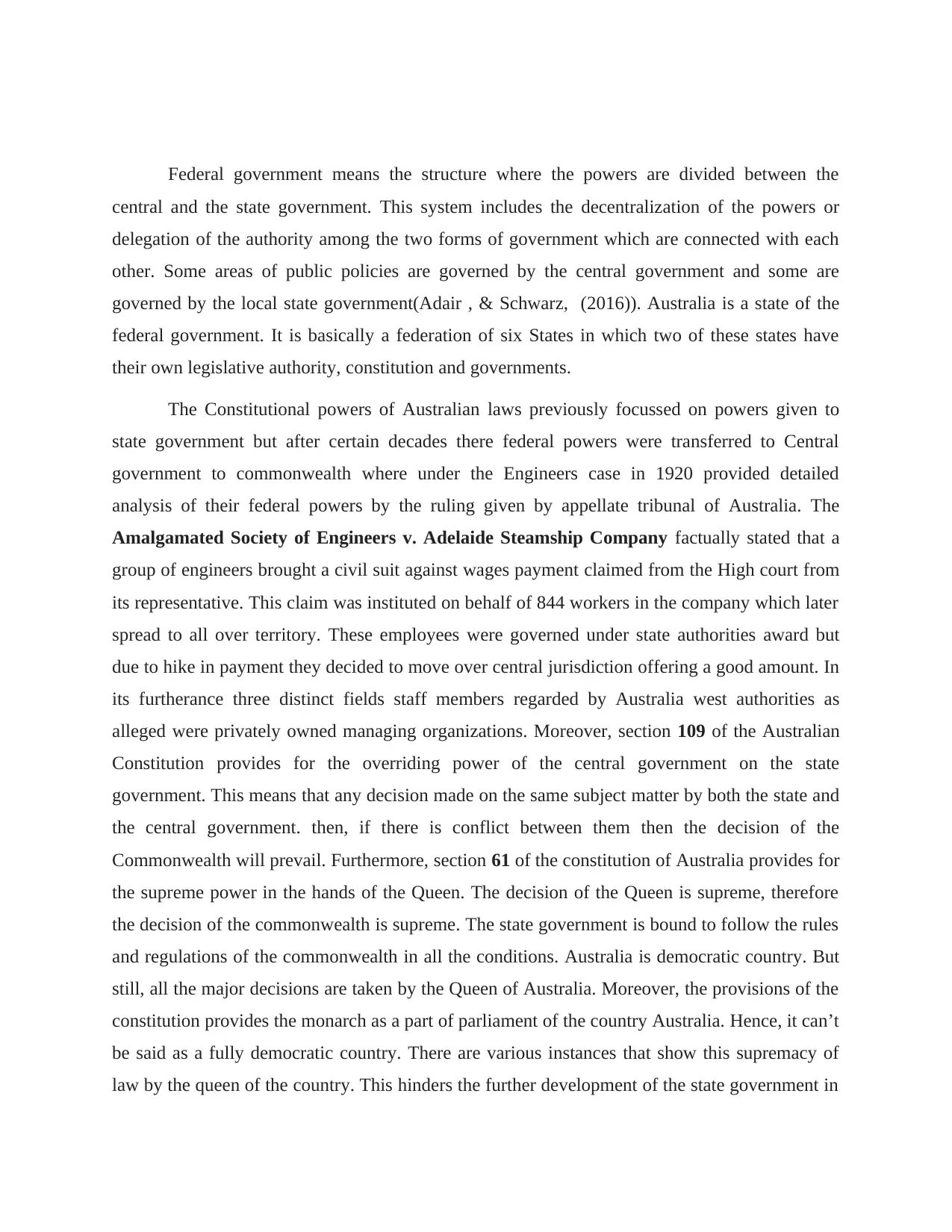
Federal government means the structure where the powers are divided between the
central and the state government. This system includes the decentralization of the powers or
delegation of the authority among the two forms of government which are connected with each
other. Some areas of public policies are governed by the central government and some are
governed by the local state government(Adair , & Schwarz, (2016)). Australia is a state of the
federal government. It is basically a federation of six States in which two of these states have
their own legislative authority, constitution and governments.
The Constitutional powers of Australian laws previously focussed on powers given to
state government but after certain decades there federal powers were transferred to Central
government to commonwealth where under the Engineers case in 1920 provided detailed
analysis of their federal powers by the ruling given by appellate tribunal of Australia. The
Amalgamated Society of Engineers v. Adelaide Steamship Company factually stated that a
group of engineers brought a civil suit against wages payment claimed from the High court from
its representative. This claim was instituted on behalf of 844 workers in the company which later
spread to all over territory. These employees were governed under state authorities award but
due to hike in payment they decided to move over central jurisdiction offering a good amount. In
its furtherance three distinct fields staff members regarded by Australia west authorities as
alleged were privately owned managing organizations. Moreover, section 109 of the Australian
Constitution provides for the overriding power of the central government on the state
government. This means that any decision made on the same subject matter by both the state and
the central government. then, if there is conflict between them then the decision of the
Commonwealth will prevail. Furthermore, section 61 of the constitution of Australia provides for
the supreme power in the hands of the Queen. The decision of the Queen is supreme, therefore
the decision of the commonwealth is supreme. The state government is bound to follow the rules
and regulations of the commonwealth in all the conditions. Australia is democratic country. But
still, all the major decisions are taken by the Queen of Australia. Moreover, the provisions of the
constitution provides the monarch as a part of parliament of the country Australia. Hence, it can’t
be said as a fully democratic country. There are various instances that show this supremacy of
law by the queen of the country. This hinders the further development of the state government in
central and the state government. This system includes the decentralization of the powers or
delegation of the authority among the two forms of government which are connected with each
other. Some areas of public policies are governed by the central government and some are
governed by the local state government(Adair , & Schwarz, (2016)). Australia is a state of the
federal government. It is basically a federation of six States in which two of these states have
their own legislative authority, constitution and governments.
The Constitutional powers of Australian laws previously focussed on powers given to
state government but after certain decades there federal powers were transferred to Central
government to commonwealth where under the Engineers case in 1920 provided detailed
analysis of their federal powers by the ruling given by appellate tribunal of Australia. The
Amalgamated Society of Engineers v. Adelaide Steamship Company factually stated that a
group of engineers brought a civil suit against wages payment claimed from the High court from
its representative. This claim was instituted on behalf of 844 workers in the company which later
spread to all over territory. These employees were governed under state authorities award but
due to hike in payment they decided to move over central jurisdiction offering a good amount. In
its furtherance three distinct fields staff members regarded by Australia west authorities as
alleged were privately owned managing organizations. Moreover, section 109 of the Australian
Constitution provides for the overriding power of the central government on the state
government. This means that any decision made on the same subject matter by both the state and
the central government. then, if there is conflict between them then the decision of the
Commonwealth will prevail. Furthermore, section 61 of the constitution of Australia provides for
the supreme power in the hands of the Queen. The decision of the Queen is supreme, therefore
the decision of the commonwealth is supreme. The state government is bound to follow the rules
and regulations of the commonwealth in all the conditions. Australia is democratic country. But
still, all the major decisions are taken by the Queen of Australia. Moreover, the provisions of the
constitution provides the monarch as a part of parliament of the country Australia. Hence, it can’t
be said as a fully democratic country. There are various instances that show this supremacy of
law by the queen of the country. This hinders the further development of the state government in
Paraphrase This Document
Need a fresh take? Get an instant paraphrase of this document with our AI Paraphraser
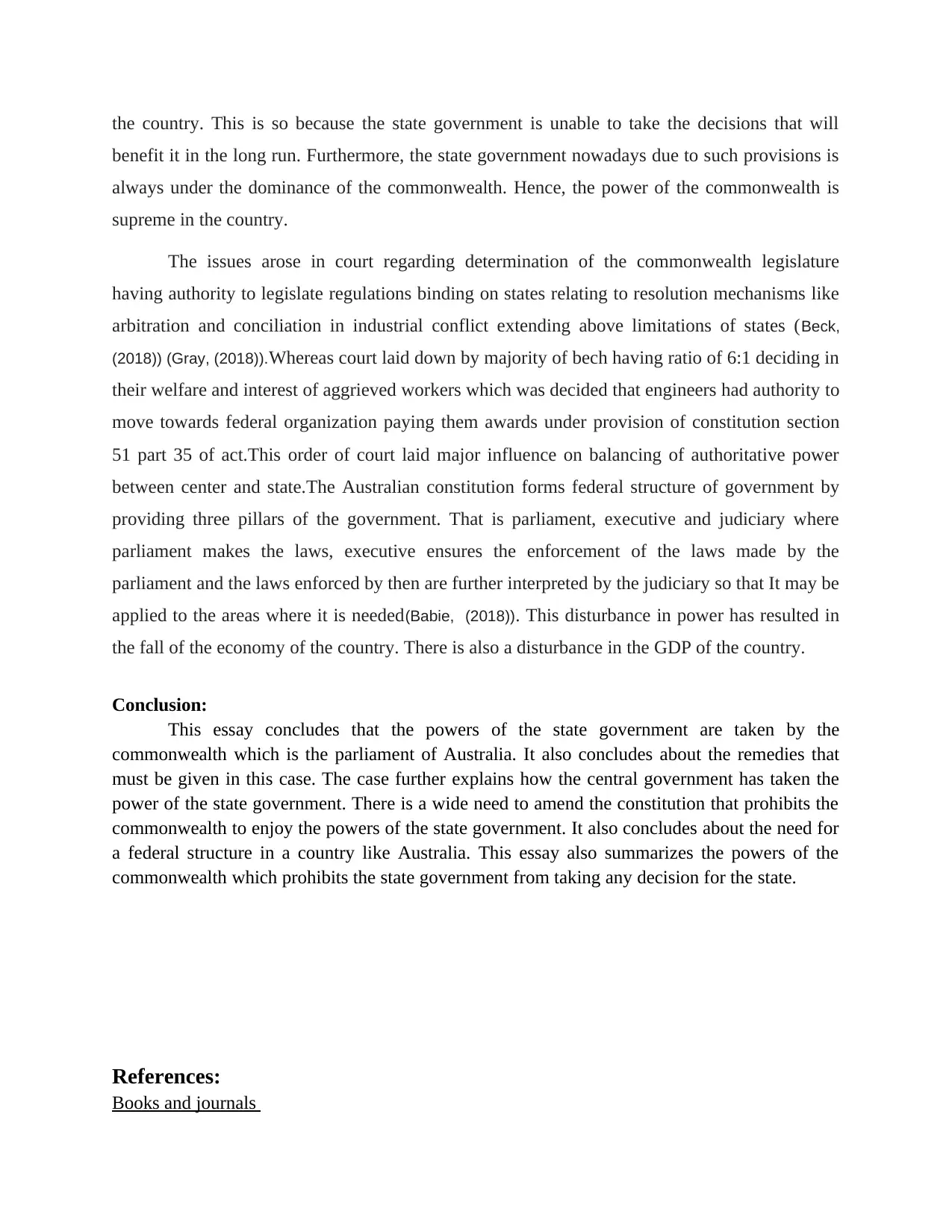
the country. This is so because the state government is unable to take the decisions that will
benefit it in the long run. Furthermore, the state government nowadays due to such provisions is
always under the dominance of the commonwealth. Hence, the power of the commonwealth is
supreme in the country.
The issues arose in court regarding determination of the commonwealth legislature
having authority to legislate regulations binding on states relating to resolution mechanisms like
arbitration and conciliation in industrial conflict extending above limitations of states (Beck,
(2018)) (Gray, (2018)).Whereas court laid down by majority of bech having ratio of 6:1 deciding in
their welfare and interest of aggrieved workers which was decided that engineers had authority to
move towards federal organization paying them awards under provision of constitution section
51 part 35 of act.This order of court laid major influence on balancing of authoritative power
between center and state.The Australian constitution forms federal structure of government by
providing three pillars of the government. That is parliament, executive and judiciary where
parliament makes the laws, executive ensures the enforcement of the laws made by the
parliament and the laws enforced by then are further interpreted by the judiciary so that It may be
applied to the areas where it is needed(Babie, (2018)). This disturbance in power has resulted in
the fall of the economy of the country. There is also a disturbance in the GDP of the country.
Conclusion:
This essay concludes that the powers of the state government are taken by the
commonwealth which is the parliament of Australia. It also concludes about the remedies that
must be given in this case. The case further explains how the central government has taken the
power of the state government. There is a wide need to amend the constitution that prohibits the
commonwealth to enjoy the powers of the state government. It also concludes about the need for
a federal structure in a country like Australia. This essay also summarizes the powers of the
commonwealth which prohibits the state government from taking any decision for the state.
References:
Books and journals
benefit it in the long run. Furthermore, the state government nowadays due to such provisions is
always under the dominance of the commonwealth. Hence, the power of the commonwealth is
supreme in the country.
The issues arose in court regarding determination of the commonwealth legislature
having authority to legislate regulations binding on states relating to resolution mechanisms like
arbitration and conciliation in industrial conflict extending above limitations of states (Beck,
(2018)) (Gray, (2018)).Whereas court laid down by majority of bech having ratio of 6:1 deciding in
their welfare and interest of aggrieved workers which was decided that engineers had authority to
move towards federal organization paying them awards under provision of constitution section
51 part 35 of act.This order of court laid major influence on balancing of authoritative power
between center and state.The Australian constitution forms federal structure of government by
providing three pillars of the government. That is parliament, executive and judiciary where
parliament makes the laws, executive ensures the enforcement of the laws made by the
parliament and the laws enforced by then are further interpreted by the judiciary so that It may be
applied to the areas where it is needed(Babie, (2018)). This disturbance in power has resulted in
the fall of the economy of the country. There is also a disturbance in the GDP of the country.
Conclusion:
This essay concludes that the powers of the state government are taken by the
commonwealth which is the parliament of Australia. It also concludes about the remedies that
must be given in this case. The case further explains how the central government has taken the
power of the state government. There is a wide need to amend the constitution that prohibits the
commonwealth to enjoy the powers of the state government. It also concludes about the need for
a federal structure in a country like Australia. This essay also summarizes the powers of the
commonwealth which prohibits the state government from taking any decision for the state.
References:
Books and journals
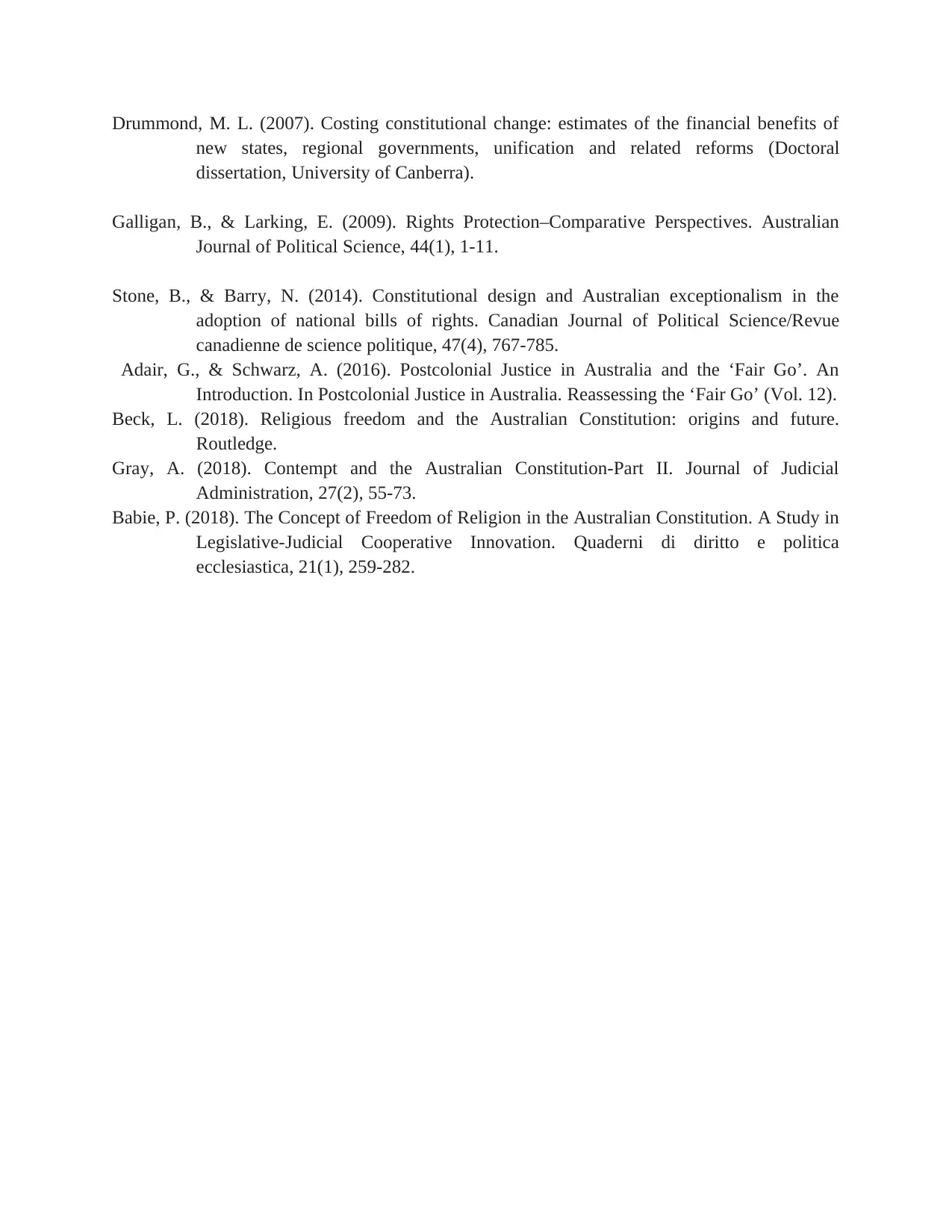
Drummond, M. L. (2007). Costing constitutional change: estimates of the financial benefits of
new states, regional governments, unification and related reforms (Doctoral
dissertation, University of Canberra).
Galligan, B., & Larking, E. (2009). Rights Protection–Comparative Perspectives. Australian
Journal of Political Science, 44(1), 1-11.
Stone, B., & Barry, N. (2014). Constitutional design and Australian exceptionalism in the
adoption of national bills of rights. Canadian Journal of Political Science/Revue
canadienne de science politique, 47(4), 767-785.
Adair, G., & Schwarz, A. (2016). Postcolonial Justice in Australia and the ‘Fair Go’. An
Introduction. In Postcolonial Justice in Australia. Reassessing the ‘Fair Go’ (Vol. 12).
Beck, L. (2018). Religious freedom and the Australian Constitution: origins and future.
Routledge.
Gray, A. (2018). Contempt and the Australian Constitution-Part II. Journal of Judicial
Administration, 27(2), 55-73.
Babie, P. (2018). The Concept of Freedom of Religion in the Australian Constitution. A Study in
Legislative-Judicial Cooperative Innovation. Quaderni di diritto e politica
ecclesiastica, 21(1), 259-282.
new states, regional governments, unification and related reforms (Doctoral
dissertation, University of Canberra).
Galligan, B., & Larking, E. (2009). Rights Protection–Comparative Perspectives. Australian
Journal of Political Science, 44(1), 1-11.
Stone, B., & Barry, N. (2014). Constitutional design and Australian exceptionalism in the
adoption of national bills of rights. Canadian Journal of Political Science/Revue
canadienne de science politique, 47(4), 767-785.
Adair, G., & Schwarz, A. (2016). Postcolonial Justice in Australia and the ‘Fair Go’. An
Introduction. In Postcolonial Justice in Australia. Reassessing the ‘Fair Go’ (Vol. 12).
Beck, L. (2018). Religious freedom and the Australian Constitution: origins and future.
Routledge.
Gray, A. (2018). Contempt and the Australian Constitution-Part II. Journal of Judicial
Administration, 27(2), 55-73.
Babie, P. (2018). The Concept of Freedom of Religion in the Australian Constitution. A Study in
Legislative-Judicial Cooperative Innovation. Quaderni di diritto e politica
ecclesiastica, 21(1), 259-282.
⊘ This is a preview!⊘
Do you want full access?
Subscribe today to unlock all pages.

Trusted by 1+ million students worldwide
1 out of 6
Related Documents
Your All-in-One AI-Powered Toolkit for Academic Success.
+13062052269
info@desklib.com
Available 24*7 on WhatsApp / Email
![[object Object]](/_next/static/media/star-bottom.7253800d.svg)
Unlock your academic potential
Copyright © 2020–2025 A2Z Services. All Rights Reserved. Developed and managed by ZUCOL.





